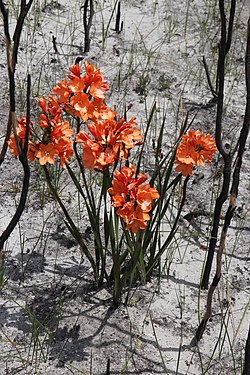| Pillansia | |
|---|---|
 | |
| Scientific classification | |
| Kingdom: | Plantae |
| Clade: | Tracheophytes |
| Clade: | Angiosperms |
| Clade: | Monocots |
| Order: | Asparagales |
| Family: | Iridaceae |
| Subfamily: | Crocoideae |
| Tribe: | Watsonieae |
| Genus: | Pillansia L.Bolus |
| Species: | P. templemannii |
| Binomial name | |
| Pillansia templemannii | |
| Synonyms [1] | |
| |
Pillansia is a genus of flowering plants in the family Iridaceae, first described as a genus in 1914. It contains only one known species, Pillansia templemannii, which is endemic to the Cape Province in South Africa. [1] [2] [3]
The genus name is a tribute to the South African botanist Neville Stuart Pillans, who brought the species to the attention of Harriet Margaret Louisa Bolus. [4]